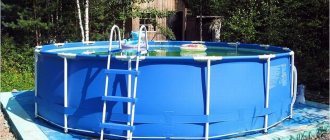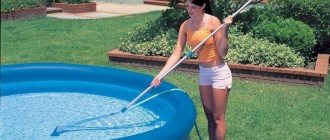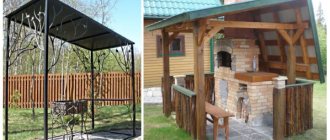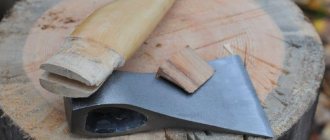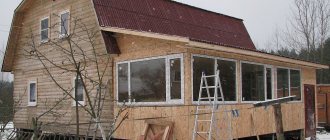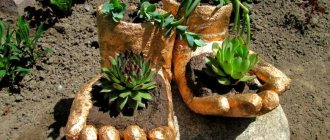Sitting near a private house or cottage in the summer heat, you probably imagined how cool it would be to plunge into the cool water of your own pool. You probably immediately drove away the thought of its construction, but it persistently returned and literally haunted you on hot days. Maybe we shouldn't give up on such an excellent idea?
After all, you can build a simple pool with your own hands, investing a minimum of money in the construction. And in this we are happy to provide you with effective assistance by providing full information support. Here you will learn about the types of artificial reservoirs and the features of choosing a location for the bowl.
We have collected for you popular design options and technologies for their construction. The detailed description is supplemented with explanatory diagrams, step-by-step photo instructions and videos.
Installation of a concrete pool
Since working with concrete mixture is familiar to most builders, a pool cast from this material is considered the most affordable option for self-production. But you can’t call it simple and easy.
Pit and sand and gravel pad
As mentioned earlier, it is best to use an excavator to dig a pit. If this is not possible, for example, there are no access roads for such bulky special equipment, you can perform this work manually, although this will require much more time.
To prevent the walls of the pit from crumbling during excavation work, they should be given a slight slope. The bottom should slope towards the drain
To prevent the walls of the pit from crumbling, they are given a slight slope during the excavation process. An additional recess is made in the center of the bottom of the bowl to create a separate drainage well. The bottom of the pit should also have a slight slope (5-7%), directed towards the place of water drainage.
Backfilling begins from the drainage well. It is simply filled with crushed stone and compacted flush with the surface of the bottom of the pit. After this, the bottom is covered with a layer of sand and gravel. At the same stage, you should consider the features of installing drain structures, etc.
First, a layer of sand about 20-30 cm thick is placed on the bottom, which is compacted thoroughly and evenly. Then a 10-centimeter cushion of gravel is laid on top, which should also be compacted.
Regardless of the shape of the bowl and the material from which it is made, the foundation pit is constructed in a certain sequence. First, the soil is selected, then communications are laid, the bottom and walls are strengthened, and finally a bowl is installed (+)
Pool bottom concreting
After installation of communications, you can begin to fill the bottom with concrete.
You can prepare the mixture yourself using the following recipe:
- 625 kg of sand;
- 325 kg of cement;
- 1250 kg of crushed stone;
- 170 liters of water.
Since you will need a lot of concrete, it makes sense to buy, rent, or even make your own concrete mixer. To calculate the required amount of mixture and its components, you can use an online calculator. Such services are available on many websites of suppliers of cement and building materials.
It also makes sense to consider purchasing ready-mixed industrial concrete, especially if special equipment can be brought directly to the construction site. In the recommendations on how to make a concrete pool with your own hands, there are two options for concreting the bottom of the pit.
In the first case, a layer of concrete screed 5 cm thick is first poured. Then a layer of reinforcement is mounted on top, which is filled with another layer of screed.
Some masters recommend reducing time and effort by using the second filling option. In this case, first install the reinforcement, which is installed at some distance from the sand and gravel cushion using supports (pieces of brick will do).
Before pouring the bottom of the pit for the pool with a concrete screed, reinforcement made of metal rods 6-8 mm thick is laid on it.
Then concrete solution is poured onto the bottom so that it covers the bottom of the pit and all the reinforcement. To prepare concrete mortar, it is recommended to use cement grade M 400 or higher. The reinforcing mesh can be made from 6-8 mm metal wire.
The recommended cell size is 150-200 mm. The rods can be welded, but it will be easier to simply fix their position with thin wire. Now you need to wait for the concrete screed to dry. From time to time, the surface of the concrete is moistened with water to ensure uniform drying.
Formwork and wall filling
Now you need to make formwork to make the walls of the pool bowl out of concrete. For this you will need a 30 mm board. You should immediately make sure that there are mounting holes in which the pool equipment will be installed.
To improve the adhesion of fresh mortar to an already laid concrete base, the base must be moistened before starting work. For the same purpose, aluminum powder is added to the solution for the first layer of wall filling.
The formwork for pouring the walls of a concrete pool can be made of boards or plywood. To increase the strength of the structure, it is reinforced with timber
It is not necessary to use new boards for formwork; even old used structures, for example, with traces of old paint, etc., will do. The main thing is that they can withstand the weight of concrete. Moisture-resistant plywood is also suitable for these purposes. It can be bent, so it is more convenient than a board when creating formwork of a non-standard configuration.
The formwork should be additionally reinforced with stiffeners. They are made from 50X50 mm timber. The ribs are installed approximately 500 mm apart. If it is planned to make a stationary staircase made of concrete, then the sheathing for it must be made separately.
The reinforcement that is needed to give the concrete walls of the pool additional strength is also made in advance. Metal rods are installed immediately after the first layer is poured, before the concrete has time to harden.
After this, the concrete is poured in layers, each about 150 mm thick. After about four days, the concrete will be hard enough for the formwork to be removed.
Waterproofing and finishing
After the concrete has completely dried, work can continue. First, waterproofing work is carried out. Some craftsmen consider it necessary to insulate only the so-called cold seams, others advise laying a layer of waterproofing over the entire surface of the pool bowl.
Roofing material is quite suitable for the role of waterproofing, the sheets of which are laid with an overlap of approximately 200 mm. You can also use liquid rubber, bitumen, PVC membrane or modern building mixtures with hydrophobic properties. It is important to take into account costs, since the area of the pool bowl is usually large, and such building mixtures are quite expensive.
Liquid waterproofing is applied to the surface of the concrete pool bowl in two layers, between which it is necessary to install a reinforcing mesh
To improve the quality of waterproofing work, you must first level the walls by sanding. If you use liquid waterproofing that is sprayed onto the walls, you need to apply two layers. In this case, it is recommended to lay a reinforcing mesh between the first and second layers.
After the waterproofing has dried, it is necessary to check its quality. To do this, the pool is filled with water and left for 10-12 days. The water level should be measured at the beginning and end of this period. A small difference between these indicators is quite expected, since water evaporates from the surface.
But if the water decreases at too high a rate, it means that the waterproofing was done incorrectly and the work should be repeated. After this, the surface of the pool can be plastered with a suitable composition to prepare the base for further finishing. A decorative border is made along the top of the pool. It can be cast from concrete or laid out from brick.
All that remains is to install the remaining equipment and then line the pool walls with finishing material. Most often, ceramic tiles are used for this. Due to the pressure of the water layer, the walls of the bowl may be slightly deformed. This does not have a very good effect on the condition of the tiles: they crack or crumble.
To prevent such an unpleasant phenomenon, you need to make a wide seam between the tiles, and use a compound with increased elasticity for grouting. It is quite difficult to lay tiles on uneven surfaces. Owners of swimming pools with complex configurations are better off using mosaics rather than tiles.
After completing the finishing work, you need to wait a little more time so that the glue has time to dry well. After this, you can fill the pool with water to check the quality of its manufacture and the operation of the equipment.
Instead of coating and penetrating options for waterproofing the walls of the pool, a polymer membrane can be used. It is recommended to lay in two layers, the seams of the material are welded with hot air (+)
Frame
A frame pool is considered a fairly simple structure, quite suitable for independent construction. Its peculiarity is its design, which consists of a frame “skeleton” made of metal pipes. The bowl is lined with three layers of PVC film. Inside it has a special mesh made of nylon, which gives the material additional tensile strength. The metal frame holds the water pressure.
It is placed with some depression in the ground or simply on the surface. The area for the pool must be prepared: remove all vegetation, and level the bottom of the shallow pit and fill it with sand or gravel. In some cases, even a concrete pad is poured.
Then the entire surface is lined with heat and waterproofing. Penofol or folitep are best suited here. These are modern thermal insulation materials made of foamed polyethylene covered with aluminum foil. The mats are laid end to end and the seams are taped with construction tape.
After this, the pool itself is assembled according to the instructions included with the kit. The only necessary tool for the job is a screwdriver.
Alternative options for constructing a bowl
When figuring out how to build a concrete pool, you should not forget about alternative options for constructing a bowl.
For its construction you can use:
- concrete or expanded clay blocks;
- expanded polystyrene blocks;
- steel sheet;
- finished structure made of fiberglass or plastic.
When using concrete blocks, the bottom of the pool is first poured, but the walls of the bowl are laid out from these same blocks. Every third row of masonry should be reinforced to give the structure additional strength. You can also make a stationary ladder from the blocks, instead of a stepladder, which is not so convenient.
The walls of the pool can be made of concrete blocks. Every third row of masonry should be reinforced. The surface of the bowl must be treated with waterproofing, and then finishing work must be carried out
Next, the bowl is processed in the same way as a monolithic structure: waterproofing and finishing work is carried out. A special PVC film can be used as a decorative covering.
It looks very attractive, costs much less than ceramic tiles, and is much easier to install. But the service life of this material is only 5-7 years, then the finish will have to be updated.
PVC film is a convenient material for finishing swimming pools. It is easy to install and looks attractive, but only lasts a few years
Large format polystyrene foam blocks are also laid on a concrete base. They are connected using grooves and ridges provided by the design.
The material is very convenient to work with because it weighs little. If necessary, the blocks are trimmed with a regular hacksaw.
It is not difficult to make a pool with walls made of polystyrene foam blocks. The structure should be reinforced, and then the concrete solution should be poured into special holes
After the masonry is completed, the pool equipment and fittings should be installed. It is placed inside the cavities existing in the blocks.
The space between the communication pipes and polystyrene foam is filled with polyurethane foam. After this, liquid concrete is pumped into the cavity with reinforcement. When the structure is dry, you can begin finishing the finished bowl.
A pool made of steel sheets can be made either on a concrete base or on carefully compacted soil, although the latter option is not as reliable as a screed. Since the steel sheet is supplied in a roll, it is most convenient to make a bowl from it in the form of a circle, oval or figure eight.
A pool made of steel sheet can be given a round or oval shape. Such structures can be recessed into the ground or located on the surface
The edges of the sheet are connected with a special profile, which avoids welding. After installing the bowl, it is covered with PVC film and filled with water so that the finishing material is pressed tightly against the walls of the bowl. To fix the film along the top of the side, use a fastening profile. After this, the technical equipment of the pool is installed.
A finished bowl made of fiberglass, plastic or modern composite materials is not a cheap pleasure, even if you choose a standard design rather than a custom-made one.
To deliver and install the bowl, you will have to use a crane and other special equipment. First you should dig a pit of a suitable configuration. Then its bottom is leveled, covered with a layer of crushed stone or gravel and compacted.
The finished pool bowl is not easy to deliver and install in the pit, but its further installation is relatively simple, since waterproofing and finishing are not needed
After this, you can lower the bowl to the bottom of the pit. The space between the walls of the pit and the bowl is filled with soil and compacted. Such structures usually do not require additional waterproofing and finishing. All that remains is to install the equipment and begin operating the pool.
The weight of such pools is usually relatively low, so owners of areas with high levels of soil freezing should exercise caution. In winter, frozen groundwater can simply push the bowl to the surface.
How to choose sites for construction.
First of all, think about the space that you can allocate on your site. The area should be open to adequate sunlight and free of trees. What harm can trees do if they provide much-needed shade on a hot day? But the problem is that, firstly, leaves or even small twigs will fall from the trees, and if the tree is a fruit tree, even more so, fruits or bugs.
It is believed that the best soil for a pool is clay. Since clay itself serves as a good barrier to ground moisture. Therefore, those who have a choice should better give preference to such a place with clay soil.
If you are going to build a pool and you have the opportunity to do this work with an excavator or use other construction equipment: a concrete mixer, a dump truck, then think about a place where these machines can drive up easily and without problems.
Also keep in mind that if the groundwater in your area lies close to the surface of the earth, namely at a depth of less than one meter, then you should not build a pool in a pit.
A low-lying area would not be the best location, because in this case the water in the pool will be polluted by rainwater.
Pros and cons of simple homemade artificial ponds
DIY pools have the following advantages:
- Easy to construct.
- Manufactured without the use of additional labor.
- Made from scrap materials.
- Requires minimal cash outlay.
- It is possible to obtain a permanent structure.
Flaws:
- Tires emit an unpleasant odor in hot weather.
- Made of polypropylene - does not hold the load well.
- Made from pallets - fragility.
- Concrete rings are heavy.
- From wooden panels - there is a risk of damage by bacteria and susceptibility to rotting.
- Containers mean high transportation costs.
- Made from cinder blocks - high cost.
Roof
An indoor pool is better than an outdoor pool in every way; here, as they say, there is nothing to argue about. But does it have to be complicated and expensive? Ready-made pools, delivered assembled, are also equipped with a lid, on the left in Fig. But this is just a note: those who can afford them don’t read the articles themselves, the referees report to them.
Roof, awning and canopy for pool
For your budget dacha, the easiest way is to buy a folding pool canopy, in the center in Fig. There is no particular point in making one yourself: there is a lot of fuss and technical problems in moving parts; a film that is resistant to bending and abrasion will also be expensive at retail. In addition to protection from dust and debris, the film canopy also provides some heating of the water due to the greenhouse effect. To jump into the pool straight from bed, in normal summer weather, it is enough to tightly fasten the canopy at night.
An even greater effect is achieved by a polycarbonate canopy over the pool; this material was specially developed for greenhouses and greenhouses. If the polycarbonate roof is made semicircular and designed so that the axis of the forming cylinder passes through the water column, then you can swim in the fall, on the right in Fig. And in summer, water heating will also operate in the fresh air, without side walls - in this case, the roof acts as a concentrator of thermal radiation.
As you can see, the result is something very similar to a greenhouse. Indeed, a swimming pool in a structure similar to a polycarbonate greenhouse can be used from spring to autumn, the entire summer season. For example, the video below shows how a certain summer resident turned a greenhouse that had become unnecessary into an indoor pool.
Video: pool from a greenhouse
What can a tank for a summer cottage be made from?
A pool can be made from various materials, the selection of which is based on the capabilities of the owner and the size of the site.
Big
To obtain a large pool, the following materials are usually used:
- pallets;
- containers;
- wooden shields.
Read more about large swimming pools here.
Small
to make a small pool :
- tires;
- concrete rings;
- polypropylene.
Please note that cinder block pools can be made to any size.
Read more information about small pools here.
Dimensions
The ratio of length and width is correlated with the general purpose. If you want to do swims, give preference to a rectangular shape. For a simple “splash”, it is better to make a round shape. Depth will also be important. If you are a fan of jumping from the side, then the bottom should be at least 1.5 m deep. To place a tower or springboard, you will need a greater depth - at least 2.5 m. But you can make the bowl deeper in the place for jumping, and then bring it to standard depth.
The biggest difficulty in creating an indoor pool with your own hands will be the combined type, which is suitable for both children and parents. The zones will have to be separated by partitions that will go from the very bottom. This way, children will be protected from falling into deep water.
Attention! In this type of pool, you should make a flat bottom that will smoothly descend. Sharp jumps are unacceptable for safety reasons, because walking along the bottom you can inadvertently miss the line and choke. Don't ignore this advice.
Buy a pool in the online store =>>
"Splash Pools"
A children's pool should be smaller than an adult's, that goes without saying. The maximum depth is 60 cm. But there are 2 more important requirements. First, a swimming pool for children needs to be filled once. No matter how you interpret it to the naughty little ones, but, excuse me, someone will relieve a small need for water without noticing it. Biocides for children's pools are commercially available, and they must be used, but still, you cannot swim there twice in the same water.
Secondly, for the same reason - there should be nothing in the pool that can hurt or be scratched. Including outer frame parts with bottom. It is impossible to force the “water mice” not to dive.
Children's pools
Of the ready-made structures, these conditions are fully satisfied by pools with inflatable sides (on the left in the figure); even better - installed on a bed of soft mats. And, as they say, in a hurry and for nothing, you can turn their own sandbox into a pool, right there on the right.
Add-ons
Making an indoor pool at your dacha with your own hands is not that difficult, but decorating it and making it a full-fledged recreation area is not easy. Pool lighting will help you with this. This way, you can enjoy swimming in the evenings. A fireplace or fire pit will also look impressive. Such elements will relax and add coziness.
Share the post “How to make an indoor pool at your dacha with your own hands + Photo: Step by step, dimensions – Review + Video” by copying the link: https://kaksdelatsvoimirukami.ru/kak-sdelat-krytyj-bassejn-na-dache-svoimi-rukami-foto -poshagovo-razmery-obzor-video/
Polypropylene
A polypropylene pool also requires a pit and pouring a concrete bowl. The polymer allows you to solve the main problem when constructing swimming pools - providing reliable waterproofing. Polypropylene is an extremely durable material and can take any shape. Pools from it are made in two ways:
- buy a ready-made bowl of the desired size and shape;
- sheet polypropylene is purchased and a bowl is made from it.
Note!
The cost of both methods is approximately the same.
Welding of sheets is carried out using a thermal welding machine - an extruder.
Polypropylene bowl - concreting
After installing the polypropylene bowl and installing all communications, concrete is poured on top again and decorative material is laid.
It is polypropylene pools that are most suitable for installation in a summer cottage. They are not afraid of temperature changes and weather vagaries.
Methods of water filtration and purification
Install a filter unit. Its functions:
- ensuring water circulation;
- removal of contaminants;
- drain water if necessary.
Such devices can self-clean. This makes it easier to maintain the structure. Filters make it possible to use the pool throughout the day, as they pass water through them many times. They are selected according to the volume of the bowl. Main types:
- sand;
- containing cartridges;
- diatomaceous.
The last option belongs to a higher price category; it captures microscopic contaminants. Cartridge models are the most popular, and the sand filter is affordable and simple, but ineffective. The elements of the system are laid into the concrete structure at the stage of preparation for pouring the formwork.
What is important
Public swimming and bathing artificial reservoirs, even if the water in them does not smell of chlorine (modern means of disinfection are much more effective and do not show themselves in public), figuratively speaking, are similar to a seriously ill patient connected to a lot of devices that replace vital organs. For them, i.e. for a closed water regeneration system, a dry technical floor is provided under the pool bowl (bathtub), which is absolutely unacceptable in all respects for the average private owner. At the dacha, with relatively low-intensity use and plenty of solar energy, it is possible to do without these difficulties: in the pool you need to create a self-sustaining environment, the sanitary and hygienic parameters of which are within the established standards. Nobody pours antiseptics into a river or lake where swimming is allowed.
Modern technologies make it possible to fit all water treatment equipment for a pool with a volume of up to 20-40 cubic meters into a small box placed in a pit or even floating in the water. Such devices are most often sold optionally, and are produced by partner companies of the manufacturers of the pools themselves. From the point of view of marketers of the consumer society, this is a brilliant move: having discovered that a decent summer pool can be bought for 4-5 thousand rubles, and assembled on site in an hour, using only a screwdriver, the consumer buys it. And a few days later, when several cubic meters of water for which you paid for it smells musty, or the kids fall ill, having swallowed liquid disinfected with improvised means, they go looking for a filter. And here it turns out that you will have to spend additional money many times or even tens of times more.
We'll figure out how to avoid these problems with minimal risk and expense. And, in addition, we will pay attention to open-type pools from the point of view of water circulation. Due to the relatively small loss of water, they create their own cycle of circulation of substances, allowing swimmers to wedge themselves into it. A garden pool is the most suitable application for such a solution, both in size and in the nature of its use. Actually, we will try to create a small reservoir with a cycle of substances close to natural; not a sterile hospital room, but a living space suitable for temporary living in it. For this, in principle, a volume of 1.5-2 cubic meters is sufficient. m, and at 40-50 cubic meters, which is the limit for a 6-acre dacha, the planned water losses will not exceed the specified 50 liters per day.
Filling and draining
It remains to analyze the features of water supply and drainage. The hydraulic design of a swimming pool is, in general, the same as that of a bathtub: spout, overflow, drain. But due to the greater height of the water layer and, accordingly, its greater pressure, the latter is not the same as in an apartment. First, instead of a plug there is a sliding or rotary valve; The pressure of the water will drive the plug tightly into the socket. Outside on the drain there is a multi-turn shut-off valve; The ball valve here does not guarantee against water hammer. To release water, they first move the valve, and then open the valve, and nothing else. Do not install a siphon on the pool drain; it will burst under pressure. Outlet pipe to the sewer – from 60 mm in diameter.

